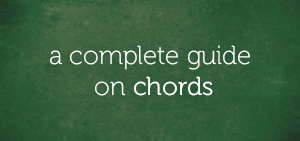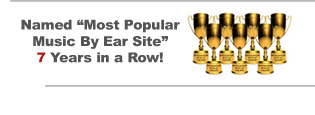In this lesson, I’ll be showing you an easier way to play regular ninth chords.
For beginners and intermediate players who are interested in playing extended chords, ninth chords are good for a start. However, a vast majority of musicians find them challenging to play.
If you give me your undivided attention for the next 10 minutes or so, I’ll be showing you how to effortlessly play ninth chords. But before we do so, let’s go ahead and review ninth chords.
A Quick Review On Ninth Chords
Ninth chords are a class of extended chords that encompass a ninth interval. Using the C major scale (as a reference):
The first tone is C:
…and the eighth tone (aka – “the octave”) is also C:
Beyond the eighth tone (which is C):
…is the ninth tone (which is D):
So, ninth chords are chords that encompass a ninth interval. Using C as a reference, ninth chords encompass the ninth interval from C to D:
Ninth Chords – Derived
Following traditional principles of chord formation in intervals of third, a third above the C major triad:
…is B:
Therefore adding a B to the C major triad produces a C major seventh chord:
A third above the C major seventh chord:
…is D:
Therefore adding a D to the C major seventh chord produces a C major ninth chord:
Simply put, adding third intervals to a triad produces a seventh chord, and adding another third interval produces a ninth chord.
“Here’s Another Example…”
A third above the D minor triad:
…is C:
Therefore adding a C to the D minor triad produces a D minor seventh chord:
A third above the D minor seventh chord:
…is E:
Therefore adding an E to the D minor seventh chord produces a D minor ninth chord:
The Challenges Of Playing Ninth Chords
One of the reasons why ninth chords are difficult to play is because they are 5-toned chords and this implies that every finger (from the thumb to the pinky) would depress a note.
Another reason is the width encompassed by ninth chords. Ninth chords are extended chords and are wider than seventh chords. Ninth chords like the C major ninth chord:
…and the D minor ninth chord are not easy to play. Heck, there are more difficult-to-play ninth chords; like the Db major ninth chord:
A vast majority of intermediate keyboard players find it difficult to play ninth chords because of the number of fingers required and the extended width of the chord. If you belong to the league of keyboard players I’m talking about, then this lesson is for you.
Let’s go ahead and learn how to form ninth chords using seventh chords.
How To Form Ninth Chords Using Seventh Chords
I assume that you’re familiar with seventh chords already. Therefore, let’s go ahead and learn how to form ninth chords using seventh chords.
Attention: If you’re not very familiar with seventh chords, learn more about seventh chords now before you proceed.
Formation Of The Major Ninth Chord
The major ninth chord can be formed using these two components:
A root note
A minor seventh chord
Playing the E minor seventh chord:
…over C root note:
…produces the C major ninth chord:
Playing a seventh chord over a root note, produces a major ninth chord. However, it is important to know the right seventh chord to play.
Always ensure that the minor seventh chord used in the formation of the major ninth chord is a major third above the root note. So, in the case of the Ab major ninth chord, the root is Ab:
…and the corresponding minor seventh chord is a major third above Ab. Due to the fact that C is a major third above Ab, the C minor seventh chord:
…played over the Ab note:
…produces the Ab major ninth chord:
Following the same procedure, every other major ninth chord can be formed as well.
Formation Of The Dominant Ninth Chord
The dominant ninth chord can be formed using these two components:
A root note
A half-diminished seventh chord
Playing the E half-diminished seventh chord:
…over C root note:
…produces the C dominant ninth chord:
Playing a half-diminished seventh chord over a root note, produces a dominant ninth chord. However, it is important to know the right seventh chord to play.
Always ensure that the half-diminished seventh chord used in the formation of the dominant ninth chord is a major third above the root note. So, in the case of the Eb major ninth chord, the root is Eb:
…and the corresponding half-diminished seventh chord is a major third above Eb. Due to the fact that G is a major third above Eb, the G half-diminished seventh chord:
…played over the Eb note:
…produces the Ab dominant ninth chord:
Following the same procedure, every other dominant ninth chord can be formed as well.
Final Words
Using the principles covered in this lesson, I’m doubly sure that ninth chords would not be difficult or challenging for you anymore.
In a subsequent lesson, we’ll explore other chord voicing techniques that can be applied in the extended chord harmony.
See you then!
Chuku Onyemachi
Latest posts by Chuku Onyemachi (see all)
- The Formation Of Diminished Seventh Chords Used To Be Challenging Until I Did This
- How To Form Seventh Chords In Two Shakes Of A Dog’s Tail Using Third Intervals And The Circle Of Fifths Chart
- I Played The 13sus4 Chord And This Happened…
- How To Build Seventh Chords Like An Architect Using “Foundation And Structure” Concept
- This 4-Week Plan Will Help You Master All The Major Scales







Comments on this entry are closed.